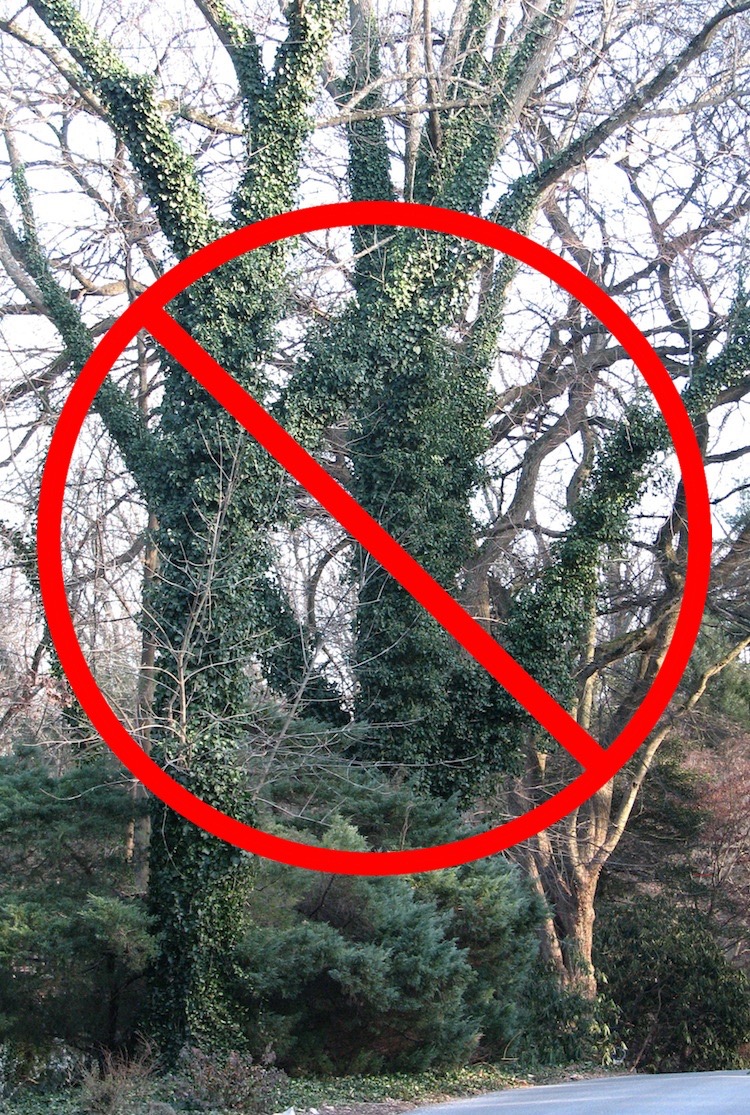
If allowed to infest trees, English ivy greatly increases their vulnerability to
blowdown, especially when loaded in winter with tons of snow or ice. It
can also transmit diseases to trees and interfere with photosynthesis
by shading tree leaves (photo by Roger Latham).
English ivy (Hedera helix) is “an aggressive invader that threatens all vegetation levels of forested and open areas” according to the National Park Service. It is a serious threat to forests and backyard trees in Rose Valley, across Pennsylvania, and throughout temperate North America.
- Its dense growth smothers native plants, preventing sunlight from reaching leaves.
- Ivy running up trees can cover branches, preventing leaf-out in the trees, eventually killing them.
- The weight of mature English ivy vines can make infested trees susceptible to blow-over during storms.
- English ivy can transmit bacterial leaf scorch, which threatens native elms, oaks and maples.
- English ivy aggressively creeps beyond its intended space into neighboring yards, parks and forests.
- Mature vines climbing trees, walls or fences produce seeds, which birds disperse to other areas.
- English ivy is not even a good bank stabilizer: its roots are shallow, and because it out-competes deeper-rooted, effective bank stabilizers, ivy-covered slopes erode significantly.
HOW TO CLEAR ENGLISH IVY FROM A TREE
Cut the stems of English ivy all the way around the tree trunk. Clear a section around the trunk at least a foot wide. Ivy dangling on the tree above the cut will eventually dry up and fall down. Cut with pruners or loppers. Large vines may require a saw, but be careful not to damage the tree’s bark.
Pull English ivy from a 3 to 6-foot circle around the base of the tree, pulling out as many roots as you can. Freeing this area of ivy will stop it from climbing back up the trunk.
Best to dispose of English ivy in a compost pile or in the trash. It resprouts easily!
USEFUL TOOLS: pruners, loppers, a portable saw for thick vines, a forked tool to pull multiple vines from the ground, elbow grease and gloved hands! (Afterwards, wash gloves in hot water just in case some of the vines were poison ivy.)
WAYS TO PREVENT ENGLISH IVY WASTE FROM RESPROUTING
- Deposit in a hot active compost pile
- Chip or chop
- Dry out in the sun on a driveway, porch or other non-soil surface
- Close up in a trash bag
Whatever you do, monitor the debris to prevent resprouting. DO NOT JUST TOSS ENGLISH IVY ONTO THE GROUND in the woods or your garden. IT WILL CONTINUE TO GROW AND SPREAD!
If chemicals are used, one can paint the cut side of the vine still in the ground with Roundup™ (or other brand of glyphosate). If applied immediately after cutting in warm weather (in the 50s or higher), this may kill the rest of the vine. This is most useful for large vines that are difficult to pull up. BE CAREFUL NOT TO GET ANY OF THE HERBICIDE ON THE TREE TRUNK OR ON NEARBY NATIVE PLANTS.
REPLANT WITH NATIVE GROUNDCOVERS
Suggestions include: wild ginger, mayapple, partridge-berry, foamflower, golden ragwort, creeping phlox, checkerberry wintergreen, Allegheny (native) pachysandra, bearberry, white wood aster, bigleaf aster, blue wood aster, smooth aster, New York aster or Christmas (evergreen) fern. Virginia-creeper is also a good native vine for natural areas but can be too vigorous for gardens. If you pull English ivy from wooded areas where it is just creeping in, native plants and seeds already in the woods should grow to fill in the cleared spaces (but watch out for other invasive plants).
(Above text adapted from www.theardens.com/weedEnglishIvy.htm)
Read more about English ivy from the Plant Conservation Alliance’s Alien Plant Working Group